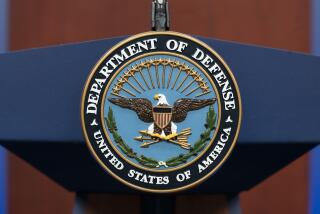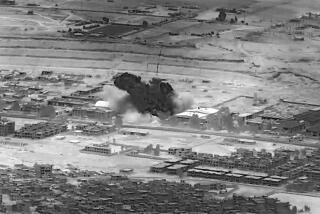Afghanistan attacks rise, U.S. says
- Share via
WASHINGTON — Insurgent activity is increasing sharply in Afghanistan and has spread into once stable areas, with attacks up almost 40% in the eastern provinces alone, according to new American military data that have prompted alarm among senior Pentagon officials.
Rising attacks against Afghan and NATO troops in the east represent the latest in a series of troubling developments that have led to markedly higher U.S. casualties and have prompted the military’s top leadership to order a review of its strategy in Afghanistan, including how to make do with limited numbers of American troops. Any significant troop increase in Afghanistan would be dependent on future force drawdowns in Iraq.
The new data, disclosed by Army Maj. Gen. Jeffrey J. Schloesser at a Pentagon news conference Tuesday, covered the first five months of the year in an area of Afghanistan that senior Pentagon officials, including Defense Secretary Robert M. Gates, have repeatedly cited as a success story. A similar assessment presented by Schloesser to top Pentagon brass in recent weeks about attacks by Islamic extremist groups sent shudders through the department, a senior military officer said.
Schloesser, the recently appointed U.S. commander in eastern Afghanistan, said attacks in the region adjacent to largely lawless areas of Pakistan are also becoming increasingly sophisticated, and blamed them for a growing number of casualties. So far this year, 50 Americans have been killed in combat in Afghanistan, compared with 28 killed through the end of June last year.
In Iraq, the trend is just the reverse. So far this year, the U.S. has suffered 207 military deaths in Iraq, compared with 576 through the end of June last year, according to the website icasualties.org.
“Folks at all levels are really taking a hard look at those statistics and saying, ‘What are they telling us?’ ” said the senior military officer, who spoke on condition of anonymity because he was not authorized to talk publicly on Afghanistan strategy. “And, more importantly, what action is appropriate to take?”
The troubling numbers, including two new NATO troop deaths Tuesday, come after a period of increasing distress on the part of military officials about the deterioration of security in Afghanistan, where the Taliban regime, which had harbored Al Qaeda, was ousted by U.S.-led forces in late 2001. Navy Adm. Michael G. Mullen, chairman of the Joint Chiefs of Staff, has spent time attempting to refocus the Pentagon’s and Capitol Hill’s attention on the Afghanistan war.
Mullen has repeatedly expressed frustration that NATO allies have not provided the numbers of troops needed to wage a complex counterinsurgency campaign. He also has expressed concern that the U.S., with continuing heavy commitments in Iraq, does not have enough combat-ready troops to fill the gap. Commanders believe that three brigades, or about 10,000 troops, are necessary.
“Violence is up this year by every single measure we look at,” Mullen told members of his staff at a public meeting Monday, noting the spread of roadside bombs known as improvised explosive devices. “The Taliban, by and large, have moved -- not unlike what happened in Iraq -- to the asymmetric, IED-style warfare.”
As part of his effort to rethink the Afghanistan mission, Mullen has asked military planners to develop new strategies for deploying additional American troops should they become available.
Last year’s troop buildup in Iraq and the overall strain on U.S. ground forces have made it almost impossible to increase force levels in Afghanistan. Many military officials, including top Army leaders, have advocated taking advantage of future troop reductions in Iraq by giving U.S. units more time at home to rest and train.
But in a shift, military planners now have agreed that future troop reductions in Iraq instead will lead to an increase in U.S. units in Afghanistan. The shift followed a lengthy internal battle, a senior Defense official said, speaking of the debate on condition of anonymity.
Still, other officials said that Pentagon planners do not know when they would have additional troops for Afghanistan because the outgoing commander in Iraq, Army Gen. David H. Petraeus, has not ordered further troop reductions.
As a result, officials at the military’s Joint Forces Command, the headquarters responsible for identifying units to be deployed overseas, have begun looking to bases in the U.S. for about 1,000 new troops that can be sent to Afghanistan in October to serve as trainers for Afghan government forces.
Gates and the Pentagon’s military leadership have identified military trainers as their biggest shortfall in Afghanistan. And the need is growing. A Marine Corps unit sent as a stopgap is due to leave Afghanistan in the fall.
Without significant numbers of new troops available, Mullen’s staff has focused on streamlining the international military command structure in Afghanistan. Critics have said that the current multi-branch structure has hampered U.S. and NATO operations by failing to effectively coordinate all military and reconstruction efforts.
Under a Pentagon proposal expected in coming weeks, all U.S. and NATO units would report to the new four-star commander in Afghanistan, U.S. Army Gen. David D. McKiernan, who heads the NATO forces. At present, efforts such as the training of Afghan security forces and aggressive counter-terrorism missions are conducted by the U.S. rather than the North Atlantic Treaty Organization.
In addition, the U.S. is close to a deal with the NATO countries that have troops in southern Afghanistan, including Britain, Canada and the Netherlands, to keep all headquarters personnel in the south for at least a year.
Southern Afghanistan has long been the most violent part of the country, and U.S. officers have complained that shorter tours of NATO commanders in the south have hampered the counterinsurgency effort. The current southern commander, Canadian Maj. Gen. Marc Lessard, is serving a 10-month tour. Incoming commanders would serve at least 12 months under the new pact. More broadly, senior U.S. military officers hope to hammer out a “comprehensive campaign plan” with NATO allies, which would include agreements on military strategy as well as such efforts as counter-narcotics programs and reinforcing the Afghan government.
But progress could prove difficult. For months, the Western forces have fought over major tenets of such a plan. For instance, U.S. officials back poppy field eradication, but British officials are opposed.
Despite the unexpected rise in violence in eastern Afghanistan, Schloesser did not call for additional forces in his region. American-led forces there are facing a patchwork of Sunni Muslim groups, unlike in the south, where the Taliban is resurgent. Schloesser attributed the increase in attacks in part to more aggressive patrols by Afghan and allied troops into previously untrod areas.
The senior military officer noted that some Pentagon officials have raised questions about Schloesser’s data, noting that as a new commander, he may be counting attacks differently than his predecessor.
Others have said violence along the Pakistani border also has had an effect in Afghanistan and have blamed the Pakistani government’s controversial efforts to strike peace deals with extremist groups in the area.
“I can’t tell you for sure the overtures they’ve made to tribes in Pakistan are directly related to the increase in violence in Afghanistan,” said the senior military official. “Do I have conclusive intel that says it is? No. Do I believe that there’s a cause and effect relationship? I do.”
--
julian.barnes@latimes.com
More to Read
Sign up for Essential California
The most important California stories and recommendations in your inbox every morning.
You may occasionally receive promotional content from the Los Angeles Times.













